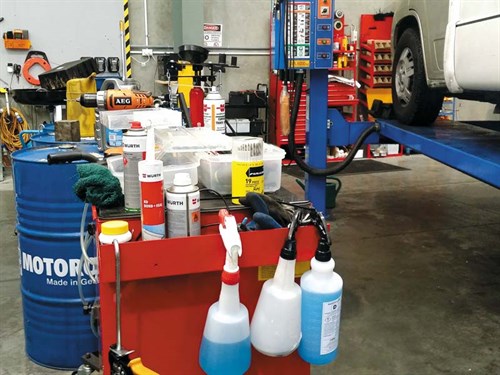
With spring just around the corner, many of you will be thinking about new travel destinations and planning summer road trips. But if your motorhome or caravan has been hibernating over winter, now’s a good time to make sure it’s road-worthy and free from any potential problems.
In the first of our new technical features, MCD talked to SmartRV’s fleet manager Patrick Frick, who joined the team at SmartRV in 2010 after moving to New Zealand from Germany. He did his apprenticeship at Mercedes-Benz in Stuttgart and was trained at the Bürstner and Hymer factories, and has experience in working on all makes and models of motorhome and is a certified self-containment officer.
1. Wheels and tyres
- Check for cracks in the sidewall of your tyres.
- Check tyre tread depth – the minimum is 1.6mm but for campers we recommend at least 3mm.
- Inspect for any punctures or flat spots. We recommend putting the vehicle on axle stands if you intend to park it over an extended period of time to avoid getting flat spots.
- Ensure your tyres are not older than seven years. An easy way to do this is to check the DOT number on the sidewall of the tyres, e.g. 1513 means the tyre was manufactured in week 15 of 2013.
- Rotate the wheels every year or at each service.
- Check brake pad thickness and disc wear as per manufacturer specifications.
- Inspect the wheels for any cracks or damage. Ensure wheel nuts are tightened to the correct torque setting. If you’re uncertain, enquire at your dealership or a trusted workshop.
2. Water system sanitation
- Empty any fresh water and flush it through before refilling. A fresh water treatment is recommended if you intend to drink the water without boiling. When refilling it is important to use drinking water.
- Clean or replace your water filter if installed. Fresh water filters are recommended and can be retrofitted to almost any vehicle.
- Sanitise your waste water tank by filling the tank completely with water and add a waste water tank treatment. Flush and repeat for best results.
3. Plumbing
- All vehicles that are self-contained have a waste trap for the shower drain, if this is accessible, we recommend opening it up and cleaning it.
- Make sure any breather hoses are not blocked with dirt as this can result in the water draining slowly.
- To ensure the vehicle is still compliant with self-containment regulations, visually inspect that waste pipes, hoses and caps are not damaged.
4. Gas appliances
- Visually inspect gas lines for damage, kinks, or cracks. Ensure gas bottles are secured and gas compartment vents are not blocked.
- Check that gas bottles are less than 10 years old.
- Although gas certificate are issued for a lifetime, we strongly recommend a certified gasfitter checks all components each year, including performing a leak test.
- It’s a good idea to install a gas detector to detect any leaks.
- Ensure any repairs on the gas system are undertaken by a certified gasfitter.
5. Safety equipment
- Test all smoke detectors to ensure they’re working properly.
- Check the pressure gauges on fire extinguishers. If it’s all ok, the needle should be sitting it the green zone. Ensure the pin is still in.
- Replenish first aid kits and check expiry dates on all items.
6. Battery
- It’s a good idea to disconnect the battery before parking up for winter. If you have a good multistage charger, it’s ok to leave it on charge over winter.
- Check battery fluid levels and top up accordingly using distilled water.
- Ensure batteries are secured, still have their breathers attached and vent to the outside of the vehicle.
- If you haven’t charged the battery over the winter, give it a good charge for at least 24 hours on mains. If in doubt, have it checked by a workshop.
7. Awning
- Visually inspect that your awning is secure and not damaged.
- Lubricate all moving components with a spray lube to allow for easy operation.
- It might also pay to fully open it and give the fabric a clean but let it dry up before putting it back together.
8. Towing gear
- Connect your caravan to your car and check the lights still work on both the car and the caravan.
- Ensure your jockey wheel is in good condition, cable and connector for lights are in good condition, safety chain and U-bolt are still there and secure, coupling operates smoothly, and that all locking pins are present and secure.
- Make sure your vehicle’s tow bar is also in good condition and is secure.
- Ensure your tow bar towing capacity is high enough for the weight of the caravan.
9. Check for leaks, inspect seals
- A simple leak check can be performed by spraying water along the seals and vents, solar, satellite etc and monitor water entry.
- We recommend having your vehicle checked yearly with a moisture meter as this will show areas of concern you might otherwise miss until it is too late and the timber framing requires an expensive repair.
10. Fluid levels
- Check engine oil, gear oil (if vehicle has dipstick for transmission), power steering fluid, windscreen washer fluid, brake fluid level and coolant and top up according to manufacturer specifications.
- Low coolant or power steering fluid levels could indicate a leak.
- Low brake fluid level usually indicates brake wear.
- Check for leaks underneath vehicle.
Never miss an issue of Motorhomes Caravans & Destinations magazine. Subscribe here.





